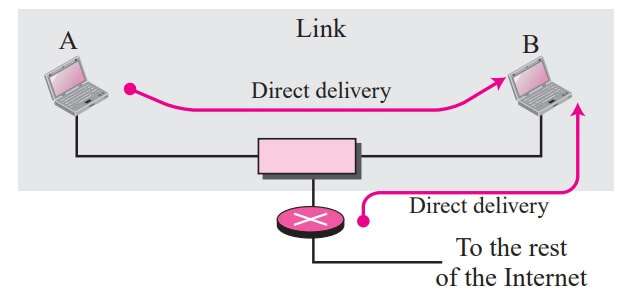Delivery
The network layer supervises the handling of the packets by the underlying physical networks. We define this handling as the delivery of a packet. The delivery of a packet to its final destination is accomplished using two different methods of delivery: direct and indirect.
Direct Delivery
In a direct delivery, the final destination of the packet is a host connected to the same physical network as the deliverer. Direct delivery occurs when the source and destination of the packet are located on the same physical network or if the delivery is between the last router and the destination host see figure.

The sender can easily determine if the delivery is direct. It can extract the network address of the destination (using the mask) and compare this address with the addresses of the networks to which it is connected. If a match is found, the delivery is direct.
In direct delivery, the sender uses the destination IP address to find the destination physical address. The IP software then gives the destination IP address with the destination physical address to the data link layer for actual delivery.
This process is called mapping the IP address to the physical address. Although this mapping can be done by finding a match in a table, we will see in next that a protocol called Address Resolution Protocol (ARP) dynamically maps an IP address to the corresponding physical address.
Indirect Delivery
If the destination host is not on the same network as the deliverer, the packet is delivered indirectly. In an indirect delivery, the packet goes from router to router until it reaches the one connected to the same physical network as its final destination.

In an indirect delivery, the sender uses the destination IP address and a routing table to find the IP address of the next router to which the packet should be delivered.
The sender then uses ARP to find the physical address of the next router. Note that in direct delivery, the address mapping is between the IP address of the final destination and the physical address of the final destination.
In an indirect delivery, the address mapping is between the IP address of the next router and the physical address of the next router. Note that a delivery always involves one direct delivery but zero or more indirect deliveries. Note also that the last delivery is always a direct delivery.
Forwarding
Forwarding means to place the packet in its route to its destination. Since the Internet today is made of a combination of links (networks), forwarding means to deliver the packet to the next hop (which can be the final destination or the intermediate connecting device). Although the IP protocol was originally designed as a connectionless protocol, today the tendency is to use IP as a connection-oriented protocol.
When IP is used as a connectionless protocol, forwarding is based on the destination address of the IP datagram; when the IP is used as a connection-oriented protocol, forwarding is based on the label attached to an IP datagram. We first discuss forwarding based on the destination address and then forwarding based on the label.
Forwarding Based on Destination Address
We first discuss forwarding based on the destination address. This is a traditional approach, which is prevalent today. In this case, forwarding requires a host or a router to have a routing table. When a host has a packet to send or when a router has received a packet to be forwarded, it looks at this table to find the route to the final destination.
However, this simple solution is inefficient today in an internetwork such as the Internet because the number of entries needed in the routing table would make table lookups inefficient.
Forwarding Techniques
Several techniques can make the size of the routing table manageable and also handle issues such as security. We briefly discuss these methods here.
Next-Hop Method : One technique to reduce the contents of a routing table is called the next-hop method. In this technique, the routing table holds only the address of the next hop instead of information about the complete route. The entries of a routing table must be consistent with each other.

Network-Specific Method : A second technique to reduce the routing table and simplify the searching process is called the network-specific method. Here, instead of having an entry for every destination host connected to the same physical network, we have only one entry that defines the address of the destination network itself. In other words, we treat all hosts connected to the same network as one single entity. For example, if 1000 hosts are attached to the same network, only one entry exists in the routing table instead of 1000.






